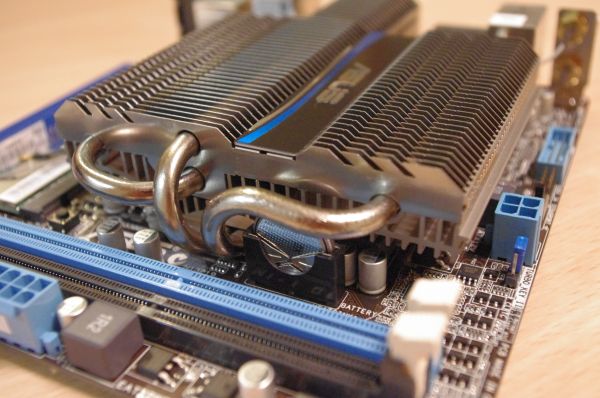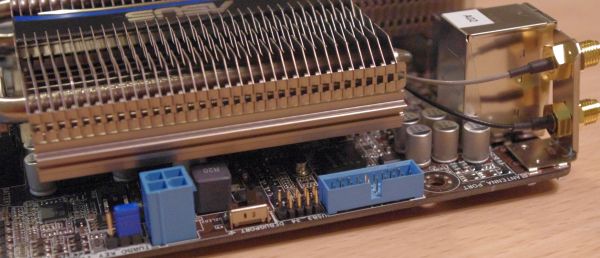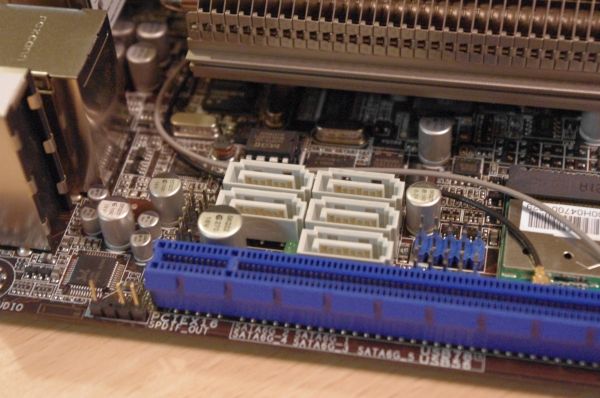Fusion E-350 Review: ASUS E35M1-I Deluxe, ECS HDC-I and Zotac FUSION350-A-E
by Ian Cutress on July 14, 2011 11:00 AM ESTEver since I first tinkered around with the ASUS board, I had a love/hate relationship with it. It's a prime example of what a lot of people may want in a board - it's passive, the wifi is already built in (you just fix the antenna), and it runs straight out of the box. But the more I prodded around the vibrant exterior, I tried to find what I would get for my $175, especially compared to the other boards I have here for review.
Despite the E-350 processor on board, the passive heatsink gets incredibly hot to touch, even at idle in a fanless environment. The CPU itself is rated at 18W, and without a discrete GPU, the board is pulling around 60W in our stringent tests. This is disconcerting, considering that the ECS board (even though it isn't passive) pulls off a 33% overclock. Also, due to the size passive heatsink, the IO panel is hit - the onboard audio has only two outputs and we're limited to DVI and HDMI video. This doesn't happen on the Zotac board, which is also passive.
Visual Inspection
I've mentioned it before and I'll mention it again - heatsink. This motherboard has a massive one, with ASUS on it, just in case you forgot. The heatsink is still shorter than any full height DDR3 memory you put in the DIMM slots, and there are two fan headers found in the top left, just beside the heatsink in that corner.
There is a USB 3.0 header along the top of the board, along with a debug header, a Turbo switch, a 4-pin 12 V CPU connector and the Clear CMOS header. Unfortunately, the writing next to these is all mixed up - the writing above the turbo switch says 'DEBUG PORT' and above the Clear CMOS is 'TURBO_KEY+II'. Nowhere on the board does it say the Clear CMOS is the Clear CMOS - during bad overclocking I had to refer to the manual to find this information.
Thankfully, the front panel connectors are still on the right hand side of the DDR3 DIMM slots (unlike the ECS), and the wifi card is preinstalled in a very tight space the other side of the DIMMs. The five SATA 6 Gbps ports are also here, with USB 2.0 headers, and the MEM OK button which is ASUS' memory adaptation feature if there is incompatibility with any memory module changes. The HD Audio header is on the far left of these headers and ports, which could cause an issue depending on where the cable is coming from and what's installed on the board. There is also a full length PCIe slot - it will accept any 16x peripheral, but run it at 4x speeds, including discrete GPUs.
The I/O panel is a mixture of positive and negative. Because of the large heatsink impinging into the panel, some of the functionality is lost. Alongside the two antenna ports, we have a single PS/2 port, four USB 2.0 ports, two USB 3.0 ports, HDMI (1.3b) and DVI video outputs, optical S/PDIF Out, a Bluetooth receiver, an eSATA 6 Gbps port, an Ethernet port and three audio jacks. The big surprise here is that the HDMI is only 1.3b and not 1.4a...




















67 Comments
View All Comments
andymcca - Friday, July 15, 2011 - link
My bad, missed this on page 11 during my first read-through.tvarad - Friday, July 15, 2011 - link
Ian,I understand your compulsions, but it's like taking a Smart, testing it like a Ferrari and then critiquing it. That's not quite what AMD had in mind on how it intended the board to be used (I own Intel stock, so this is not about taking sides). I have the Asus board and I am using it with a tiny brick that puts out about 47W and powers a Pico-psu 120W 12V-25V wide input range power supply. It's function is as a HTPC/Video Server, hence I have just a 2TB WD HD attached to it, with an external removable media drive. With 2GB Gskill Eco Ram and a 140MM fan, it never goes above 40W when booting up and idles at around 22-23W. With 1080P mkv content play, the consumption goes upto about 30W. I don't plan to overclock it. I'll go out on a limb and say that my rig is more representative of how the board will be used in the real world.
BTW, the square thingies on the pico-psu (at least the model I'm using) jut out onto the second dimm slot rendering it useless. Something you may want to watch out for.
triclops41 - Thursday, July 14, 2011 - link
Easy there, Finally,There are things to criticize about this review on benchmarks chosen or other technical details, but I have not seen any pro atom or anti brazos bias by Ian, or anyone else at Anandtech. Maybe some bias towards synthetic benchmarks, that Intel often wins, but that has more to do with the constraints of hardware reviews, not allegiance to some producer.
Finally - Tuesday, July 26, 2011 - link
Well said. I still really wonder, why there are so many encoding benchmarks here. After all - how many people actually do encode videos? I've never done so my whole life and don't intend starting to. The funny thing is that these are usually the benchmarks where the press is deriving their ridiculous high speed advantages of new Intel CPUs from...If someone came along and said that this "advantage" is completely lost on them, those CPUs wouldn't be that great, because real world game fps are almost always very close to each other...
corporategoon - Thursday, July 14, 2011 - link
I don't really have any comments on the benchmarks or thoroughness or balance of this article (seems fine to me) but this is one of the most poorly-written articles I've ever seen on AnandTech. Anand has a serious problem with sentence fragments but most articles that appear on the site are reasonably well-written. The opening paragraph is borderline unreadable.new-paradigm - Thursday, July 14, 2011 - link
Ok, I may be being dense, but I cant seem to find if any of these boards offer video and sound through the HDMI port?jrs77 - Thursday, July 14, 2011 - link
I've got two miniITX Atom boards. A Zotac IONITX A-E and an ASUS AT3IONT-I Deluxe (both sporting an onboard PSU with a 90Watt powerbrick !!!). Both of them do work like a charm and I'm even capable of playing MMOs (EvE Online) on them in low settings. They draw some 35 Watt from the plug in the wall under load.So why there's no comparison to the Atom-ION boards as they're the direct competition and on the market for a few years now allready?
stmok - Friday, July 15, 2011 - link
While the overall article is OK, it just doesn't have that usefulness of your typical Anandtech article in some areas that make it stand out.For example:
Why did you not include the ECS solution alongside the ASUS one for the overclock part on page 15?
=> http://www.anandtech.com/show/4499/fusion-e350-rev...
What about assessing noise?
=> Sure, you have the two passive mobos, but how loud/quiet was that fan cooled one?
futurepastnow - Friday, July 15, 2011 - link
Looks like the big heatsink ASUS uses is mostly for show since the much smaller one on the Zotac board puts it to shame.beginner99 - Friday, July 15, 2011 - link
... of bobcat. In the forums you can read it having trouble with 1080p sometimes especially flash. Not ideal for a htpc. The GPU part is mostly useless for a HTPC or NAS. Also these mini-ITX boards are pretty expensive and mini-ITX + core i3 doesn't cost much more and would also not use much more power in idle/normal usage but better max. performance for like flash (HTPC) or Software RAID 5 (NAS).Especially for a NAS the price difference is minimal because any small case with lots of HDD bays is pretty expensive.